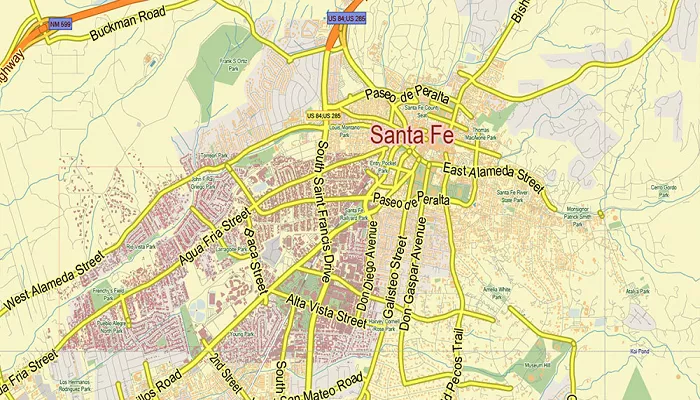Santa Fe, the capital of New Mexico, is a city rich in history and culture. Located in the north-central region of the state, Santa Fe stands as the oldest state capital in the United States and the oldest continuously inhabited city north of Mexico. Its unique blend of indigenous, Spanish, and American influences has earned it the title of the cultural capital of the Southwestern United States.
Location of Santa Fe on the Map
Situated at an elevation of 6,998 feet (2,133 meters), Santa Fe is the highest capital city in the U.S. The city is approximately 60 miles (97 kilometers) north of Albuquerque, the state’s largest city, and is positioned at latitude 35.6868° N and longitude 105.9378° W. This strategic location places Santa Fe along major transportation routes, making it a central hub for travelers and traders throughout its history.
Historical Significance
Founded in 1610, Santa Fe has a storied past that reflects the convergence of various cultures and historical events.
1. Spanish Colonial Era
In 1610, Santa Fe was established as the capital of the Spanish province of New Mexico. The city was built upon the site of a prehistoric Tiwa pueblo, and archaeological research is conducted in the surrounding Indian territory. The Palace of the Governors, constructed during this period, stands as the oldest continuously used seat of government in North America.
2. Pueblo Revolt and Mexican Era
In 1680, the Pueblo Revolt led to the temporary expulsion of the Spanish from Santa Fe. The Spanish regained control in 1692, and the city continued to prosper under Spanish rule. Following Mexico’s independence from Spain in 1821, Santa Fe became the capital of the Mexican province of New Mexico.
3. American Acquisition and Statehood
The United States acquired Santa Fe in 1846 during the Mexican-American War. The city was later incorporated into the U.S. state of New Mexico upon its statehood in 1912.
Cultural Landscape
Santa Fe’s cultural landscape is a tapestry woven from its diverse historical influences. The city is renowned for its Pueblo-style adobe architecture, characterized by earth-toned buildings with flat roofs and exposed wooden beams. This architectural style reflects the city’s indigenous and Spanish heritage.
Art and Architecture
Santa Fe boasts a vibrant arts scene, with over 250 art galleries and numerous museums. The Georgia O’Keeffe Museum houses a significant collection of works by the American modernist painter. The Museum of International Folk Art features a vast array of traditional folk art from around the world. Additionally, the city hosts annual events such as the Santa Fe Indian Market and the Traditional Spanish Market, celebrating its rich cultural heritage.
Historic Sites
The Santa Fe Plaza serves as the city’s historic center, surrounded by significant landmarks including the Palace of the Governors and the Cathedral Basilica of St. Francis of Assisi. The Loretto Chapel, known for its miraculous spiral staircase, is another architectural marvel that draws visitors from around the world.
Culinary Scene
Santa Fe’s culinary offerings are a fusion of Native American, Spanish, and Anglo influences. The city is renowned for its New Mexican cuisine, featuring dishes like enchiladas, tamales, and the distinctive green chile stew. Local markets and festivals often showcase traditional foods, providing a sensory journey through the region’s flavors.
Festivals and Events
Throughout the year, Santa Fe hosts a variety of cultural festivals that celebrate its diverse heritage. The Santa Fe Opera presents performances in a stunning open-air theater, offering a unique operatic experience against the backdrop of New Mexico’s desert landscape. The Spanish Market and Indian Market are annual events that attract artisans and visitors globally, highlighting traditional crafts and artworks.
Natural Beauty and Recreation
Surrounded by the Sangre de Cristo Mountains, Santa Fe offers abundant opportunities for outdoor activities. Hiking, skiing, and mountain biking are popular pursuits, with numerous trails and parks accessible within and around the city. The nearby Santa Fe National Forest provides expansive natural spaces for exploration and recreation.
Modern Santa Fe
Today, Santa Fe continues to thrive as a cultural and artistic hub. Its population of approximately 80,000 residents enjoys a high quality of life, with access to excellent healthcare, education, and a vibrant community life. The city’s economy is bolstered by tourism, the arts, and a growing tech industry, all while maintaining its historic charm and cultural traditions.
Santa Fe Compared to Other Southwestern Cities
How does Santa Fe compare to other major Southwestern cities?
| City | State | Distance from Santa Fe | Key Difference |
|---|---|---|---|
| Albuquerque | NM | 60 miles | Larger, more modern |
| Denver | CO | ~330 miles | Bigger metro, lower elevation |
| Phoenix | AZ | ~500 miles | Hotter, urban sprawl |
| Las Vegas | NV | ~600 miles | Glitzier, desert entertainment hub |
Santa Fe stands out for its history, art, and mountain setting.
Conclusion
Santa Fe’s unique blend of history, culture, and art makes it a must-visit destination in the southwestern United States. Its location at the crossroads of ancient trade routes and its status as a cultural center continue to define its character and allure. Whether you’re exploring its historic sites, enjoying its artistic offerings, or simply soaking in the scenic beauty, Santa Fe offers a rich and rewarding experience for all who visit.

